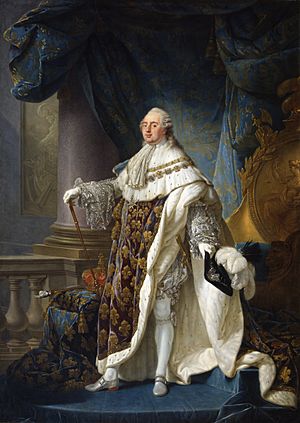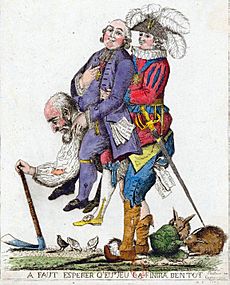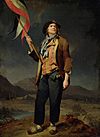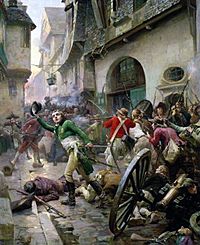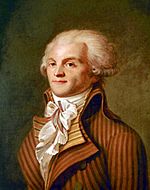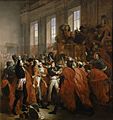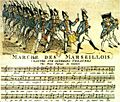French Revolution facts for kids

The Storming of the Bastille, 14 July 1789
|
|
| Date | 5 May 1789 – 9 November 1799 (10 years, 6 months and 4 days) |
|---|---|
| Location | Kingdom of France |
| Outcome |
|
The French Revolution was a big change in France that happened between 1789 and 1799. It marked the end of the monarchy, which meant France no longer had a king. King Louis XVI was executed in 1793. The revolution ended when Napoleon Bonaparte took power in November 1799. A few years later, in 1804, Napoleon became an Emperor.
Before 1789, France was mostly controlled by the nobles and the powerful Catholic Church. But new ideas from the Enlightenment were spreading. Ordinary people started wanting more say in how their country was run. They saw how the American Revolution had created a country where people had power, not just a king. The old system of government in France was called the "Ancient Regime."
Contents
Why the Revolution Started
Many problems in France led to the Revolution:
- Money troubles: Under Kings Louis XV and Louis XVI, France spent a lot of money fighting wars, like the Seven Years' War against Prussia and the British Empire, and later helping in the American Revolution. This left the country very poor.
- Hunger and poverty: The price of bread was very high, and workers' wages were low. This meant many ordinary people suffered from hunger and malnutrition. They grew to dislike the rich nobles, who lived in luxury and had plenty to eat.
- Unfair taxes: The Roman Catholic Church, which owned most of the land, collected a tax on crops called the dime (or tithe). This tax hurt the poorest and hungriest people the most, as they struggled to pay it.
- New ideas: Ideas from the Enlightenment made many people dislike the idea of kings having absolute power and nobles having special rights. They saw that in countries like the United States, ordinary people had more power in government. They also wanted freedom of religion.
- Unequal system: French society was divided into three groups called Estates. The first two Estates (the Clergy and the Nobility) had many special rights and didn't pay many taxes. But the Third Estate (which included everyone else, like middle-class people, city workers, and peasants) had to pay most of the taxes.
The Estates-General Meeting
Before the Revolution, French society was divided into three main groups, or Estates:
- The First Estate was the Clergy (church officials). They made up about 1% of the population.
- The Second Estate was the Nobles. They also made up about 1% of the population.
- The Third Estate included almost everyone else, about 98% of the population. This group included farmers, city workers, and the middle class.
Representatives from all three Estates sometimes met together in a group called the Estates-General.
In May 1789, King Louis XVI called a meeting of the Estates-General at the royal Palace of Versailles. He hoped they could help solve the country's money problems. However, the members of the Third Estate were very angry. They had brought lists of problems they wanted to fix, called the Cahiers de Doléance.
The commoners in the Third Estate were upset because they were the poorest group but paid the most taxes. They, along with the King's finance minister, Jacques Necker, believed the Church and the Nobility should pay more taxes.
They also wanted a fairer voting system. Even though the Third Estate had many more members than the other two Estates, each Estate only had one vote. This meant the First and Second Estates could always outvote the Third Estate. The Third Estate wanted each member to have one vote. But the other Estates disagreed.
Starting the National Assembly
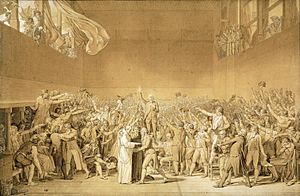
Since the First and Second Estates wouldn't listen, the Third Estate decided to form their own assembly. On June 10, 1789, they created the National Assembly. The King tried to stop them by closing their meeting room. But they found another place to meet: an indoor tennis court. On June 20, they took the Tennis Court Oath. They promised not to stop meeting until they had written a new constitution for France.
The Storming of the Bastille
In July 1789, after the National Assembly was formed, the nobility and the King were angry with Jacques Necker, the finance minister, and fired him. Many people in Paris thought the King was going to shut down the National Assembly. Soon, Paris was filled with riots and looting.
On July 14, 1789, the people decided to attack the Bastille prison. The Bastille held weapons and was also a strong symbol of the King's power and the nobility's rule. By the afternoon, the people had broken into the Bastille and freed the seven prisoners inside.
The members of the Third Estate took control of Paris. Jean-Sylvain Bailly, who was president of the National Assembly, became the new mayor of the city. Jacques Necker got his job back. Soon, the King visited Paris and wore the red, white, and blue (tricolor) ribbons that the revolutionaries wore. By the end of July, the revolution had spread across all of France.
The National Assembly Makes Changes
The National Assembly quickly started making many changes. On August 4, they ended the special taxes the Church collected and stopped the special rights of the Nobility. This officially ended feudalism in France. On August 26, the National Assembly published the Declaration of the Rights of Man and of the Citizen. This important document was written by the nobleman Marquis de Lafayette.
The National Assembly then worked on how the new government would be set up under the constitution. Many members, especially nobles, wanted two houses of government, like a senate. But most people voted to have just one assembly. The King was given a suspensive veto, meaning he could only delay laws, not completely stop them. In October 1789, after a large group of women attacked the Palace of Versailles, the King was convinced by Lafayette to move from Versailles to the palace in Tuileries, in Paris.
The Assembly began to divide into different political parties. One party was against the revolution, led by nobleman Jacques Antoine Marie de Cazales and churchman Jean-Sifrien Maury. This party sat on the right side. A second party, the Royalist democrats, wanted a system like Britain's constitutional monarchy, where the king would still be part of the government. Jacques Necker was in this party. The third party was the National Party, which was more in the center or slightly left. This group included Honoré Mirabeau and Lafayette.
How the French Church Changed
Under the new government, the Roman Catholic Church would have much less power. In 1790, all the Church's special taxes and powers were removed. All the Church’s property was taken over by the state. On July 12, 1790, a new law called the Civil Constitution of the Clergy made all clergy (church officials) employees of the state. They had to take an oath to the new constitution. Many clergy and even Pope Pius VI did not like these changes. Many who refused the oath faced harsh consequences.
Working on the Constitution
On July 14, 1790, one year after the storming of the Bastille, thousands of people gathered in the Champs de Mars to celebrate. Charles Maurice de Talleyrand led the crowd in a religious ceremony. The crowd, including the King and his family, promised their loyalty to “the nation, the law, and the king.” However, many nobles were unhappy with the revolution and were leaving the country. They were called émigrés (people who emigrate).
Even though the members of the Estates-General were only elected for a year, the members of the Assembly had all taken the Tennis Court Oath. They had promised to keep working until they had a constitution, and it wasn't finished yet. So, it was decided that the members would continue their work.
The Assembly kept working on the constitution and making more changes. Nobles could no longer pass their titles to their children; only the king could do this. For the first time, trials with juries were held. All trade barriers inside France were removed, along with unions, guilds, and workers' groups. Strikes were banned.
Many people with strong ideas started forming political clubs. The most famous was the Jacobin Club, which had left-wing ideas. A right-wing club was the Club Monarchique. In 1791, a law was suggested to stop noble émigrés from leaving the country. Mirabeau was against this law, but he died on April 2. By the end of the year, the law was passed.
Royal Family Tries to Leave Paris
King Louis XVI didn't like the revolution, but he didn't want to ask other countries for help or run away like the émigrés. General Bouille shared his views and wanted to help the king leave Paris. He offered the King and his family help and support at his camp in Montmédy. The escape was planned for June 20, 1791.
Dressed as servants, the royal family left Paris. But their escape wasn't well planned, and they were arrested at Varennes on the evening of June 21. The royal family was brought back to Paris. The Assembly imprisoned Louis and his wife Marie Antoinette, and suspended the king from his duties.
Finishing the Constitution
Even though the king had tried to escape, most members of the Assembly still wanted to include him in their government, rather than have a Republic with no king at all. They agreed to make the king a figurehead, with very little power. The king would have to take an oath to the state. If he didn't, or if he created an army to attack France, he would no longer be king.
Some people, like Jacques Pierre Brissot, didn't like this. They thought the king should be completely removed. Brissot created a petition, and a huge crowd came to the Champs de Mars to sign it. Republican leaders Georges Danton and Camille Desmoulins gave speeches.
The National Guard, led by Lafayette, was called to control the crowd. The crowd threw stones at the soldiers, who first fired their guns over their heads. When the crowd kept throwing stones, Lafayette ordered them to fire at the people. Up to 50 people were killed. After this, the government closed many political clubs and newspapers. Many radical left-wing leaders, including Danton and Desmoulins, ran away to England or hid in France.
Finally, the constitution was finished. Louis XVI was put back on the throne and came to take his oath to it. He wrote, “I promise to uphold it at home, to defend it from all attacks from abroad, and to make sure it is followed using all the means I have.” The National Assembly decided it would stop governing France on September 29, 1791. After that date, the Legislative Assembly would take over.
The Legislative Assembly (1791-1792)
The new Legislative Assembly met for the first time in October 1791. Under the Constitution of 1791, France was a Constitutional Monarchy. This meant the King shared his power with the Legislative Assembly, but he could still veto (stop) laws he didn't like. He also had the power to choose ministers.
The Legislative Assembly had about 745 members. About 260 of them were “Feuillants,” who supported a constitutional monarchy. About 136 were Girondins and Jacobins, who were left-wing republicans and did not want a king. The other 345 members were independent, but they usually voted with the left wing.
The Legislative Assembly often disagreed. The King used his veto to stop laws that would sentence émigrés to death. Since many Assembly members were left-wing, they didn't like this.
Crisis and War
People started turning against King Louis XVI. On August 10, 1792, a revolutionary group called the Paris Commune attacked the Tuileries Palace, where the King and Queen lived. The King and Queen were taken prisoner. The Legislative Assembly held an emergency meeting. Even though only a third of the members were there (mostly Jacobins), they suspended the King from his duties.
The kings and emperors of many foreign countries were worried about the French Revolution. They didn't want revolutions in their own countries. On August 27, 1791, Leopold II of Austria, Frederick William II of Prussia, and Louis XVI’s brother-in-law, Charles-Philippe, wrote the Declaration of Pillnitz. This Declaration asked for Louis XVI to be set free and the National Assembly to be ended. They threatened to invade France if their requests were ignored. The revolutionaries took this threat very seriously.
With the Legislative Assembly in place, the problems didn't go away. The Girondins wanted war because they wanted to spread the revolution to other countries. The King and many of his supporters, the Feuillants, also wanted war because they thought it would make the King more popular. Many French people worried that the émigrés would cause trouble against France in foreign countries.
On April 20, 1792, the Assembly voted to declare war on Austria. They planned to invade the Austrian Netherlands, but the revolution had made the French army weak. Many soldiers deserted. Soon, Prussia joined Austria. Both countries planned to invade France. Together, on July 25, they wrote the Brunswick Manifesto, promising that if the royal family was not harmed, no civilians would be hurt in the invasion. The French believed this meant King Louis XVI was working with the foreign kings. Prussia invaded France on August 1, 1792. This first part of the French Revolutionary Wars lasted until 1797.
September Massacres
In September, things got worse. The Legislative Assembly had almost no power. No single group was fully controlling Paris or France. The country was being invaded by the Prussian Army. The revolutionaries became very angry and violent. They started going into prisons and killing people they thought were traitors to France. They especially disliked the priests of the Roman Catholic Church, but they also killed many nobles and ordinary people. By September 7, about 1,400 people had died.
The National Convention (1792-1795)
The Legislative Assembly had lost all its power. France needed a new government. On September 20, 1792, the National Convention was formed. The Convention included both Girondins and the more radical Jacobins.
King Louis XVI is Executed
The Brunswick Manifesto had made many people suspicious of the king. They thought he was secretly working with the Prussian and Austrian rulers to invade France. In January 1793, the National Convention voted and found Louis XVI guilty of “conspiracy against public liberty and general safety.” On January 21, the King was executed using the guillotine. Marie Antoinette, the Queen, was also executed on October 16.
Revolt in Vendée
People in the area of Vendée did not like the revolutionary government. They disliked the new rules about the church from the Civil Constitution of the Church (1790) and new taxes put in place in 1793. They also didn't like being forced to join the French army. In March, they rose up against the government in a revolt. This war lasted until 1796. Hundreds of thousands of people from Vendée were killed by the Revolutionary French army.
The Jacobins Take Power
After the king's death, the National Convention created a new republican constitution that began on June 24. It was the first one that didn't include a king and gave every man in France a vote. However, it never fully came into power because of problems between the Jacobins and Girondins. The war with Austria and Prussia was causing money problems for the state. Bread was very expensive, and many people wanted things to change. In June 1793, the Jacobins began to take power. They wanted to arrest many Girondin members of the National Convention. In July, they became even angrier when Charlotte Corday, a Girondin, killed Jean-Paul Marat, a Jacobin leader.
By July, the coup was complete. The Jacobins had taken control. They put in new, radical laws, including a new Republican Calendar with new months and ten-day weeks. They made the army bigger and changed the officers to people who were better soldiers. Over the next few years, this helped the Republican army push back the attacking Austrians, Prussians, British, and Spanish.
The Reign of Terror
In July 1793, a Jacobin named Maximilien de Robespierre and eight other leading Jacobins set up the Committee of Public Safety. This became the most powerful group in France. This group and Robespierre were responsible for the Reign of Terror. Robespierre believed that if people were afraid, the revolution would succeed better. The Reign of Terror lasted from the spring of 1793 to the spring of 1794.
It wasn't just nobles who died during the Reign of Terror. Anyone who broke the Jacobins' laws, or was even suspected of working against them, could be arrested and sent to the guillotine. Many were executed without a fair trial. Even powerful people who had been involved in the Jacobin takeover were executed. Prisoners were taken from the prisons to “Madame Guillotine” (a nickname for the guillotine) in an open wooden cart called the tumbrel.
Records show that 16,594 people were executed by guillotine. It's possible that up to 40,000 people died in prison or were killed during the Reign of Terror.
By July 1794, people started turning against Maximilien de Robespierre. He and his Revolutionary Tribunal had executed 1,300 people in just six weeks. On July 27, the National Convention and the Committee of Public Safety turned against him. Robespierre tried to get help from the Convention’s right-wing members, but he failed.
A day later, Robespierre and many of his supporters were sentenced to death by guillotine without any kind of trial. This reaction against Robespierre is called the Thermidorian Reaction.
Now that the terror was over, the National Convention started to write a new Constitution, called the Constitution of the Year III. On September 27, 1794, this constitution came into effect.
The Directory (1795-1799)
The new constitution created the Directoire (Directory), which was the first government of France to be bicameral (split into two houses). The lower house, the parliament, had 500 members and was called the Conseil de Cinq-Cent (Council of Five Hundred). The upper house, the senate, had 250 members and was called the Conseil des Anciens (Council of Elders). Five directors were chosen each year by the Conseil des Anciens from a list made by the Conseil de Cinq-Cent. This group of five directors was in charge and was called the Directory.
While the constitution of 1793 had given all men in France a vote, in this new constitution, only people who owned a certain amount of property could vote. The Directory was much more conservative than the governments France had seen since 1789. People were tired of constant changes and unstable governments. Things were more stable under the Directory than they had been before.
However, the Directors were not liked by the people, especially the Jacobins (who wanted a republic) and the royalists (who wanted a new King). France’s money problems continued. The Directors sometimes ignored election results if they didn't like them. They also ignored the constitution to control the people. They used the ongoing war and the army to keep their power.
Coup of 18 Brumaire
The 18 Brumaire marks the end of the Republican part of the French Revolution when Napoleon Bonaparte took control of the government.
Related pages
Images for kids
-
By 1789, France was the most populous country in Europe.
-
The regional Parlements in 1789; note area covered by the Parlement de Paris
-
The Storming of the Bastille on 14 July 1789; the iconic event of the Revolution, still commemorated each year as Bastille Day
-
The Declaration of the Rights of Man and of the Citizen of 26 August 1789
-
Georges Danton; Robespierre's close friend and Montagnard leader, executed 5 April 1794
-
Former Viscount and Montagnard Paul Barras, who took part in the Thermidorean reaction and later headed the French Directory
-
Troops under Napoleon fire on Royalist insurgents in Paris, 5 October 1795
-
Napoléon Bonaparte in the Council of 500 during 18 Brumaire, 9 November 1799
-
French victory at the Battle of Valmy on 20 September 1792 validated the Revolutionary idea of armies composed of citizens
-
The Saint-Domingue slave revolt in 1791
-
Olympe de Gouges, Girondist author of the Declaration of the Rights of Woman and of the Female Citizen, executed in November 1793
-
The 1793 War in the Vendée was in part sparked by opposition to state persecution of the Catholic church
-
The Brabant Revolution broke out in the Austrian Netherlands in October 1789, inspired by the revolution in neighbouring France, but had collapsed by the end of 1790.
See also
 In Spanish: Revolución francesa para niños
In Spanish: Revolución francesa para niños


